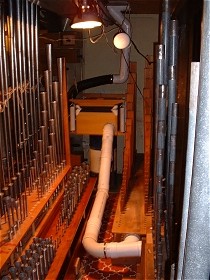
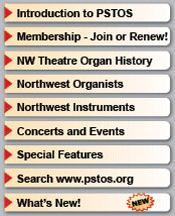

Hemmi Residence - 3/12 hybrid
Tacoma, Washington
Back to the Private Residence Installations page

Rodgers console for the 3/11 instrument
From Ron Hemmi (January 2004):
It all started around 1970 when Homer Johnson acquired the Echo organ from the Bible Presbyterian Church in Tacoma. He put a little console on it and had something to practice on. It had a stopped flute, a string celeste, vox and diapason. In ’73, there was a need for a studio organ for Homer's new wife, Jane McKee, to give lessons. A Rodgers model 33e console was ordered without any generators and a Peterson relay was built to play the pipes. A Meidinger blower provided wind and Organ Supply regulators and trems were purchased. This was all installed into the basement of their home. An organ chamber was constructed in the basement, and the stairwell provided a sound path to the upstairs portion of the house. Around ’77 and ’78, Homer purchased a Tibia and a 4 rank Wurlitzer chest originally from the Paris theatre in Denver, Colorado Opus 17 Style 6. He also acquired a Cornopean from somewhere that provided the reed tone.
A set of Wicks shutters was added between the chamber and chute for dynamics, and a computer relay built by Tom Caulton replacing the diode switch from Peterson. This gave me easy expandability, a limitless combination action, record and playback and a tune mode so I can play ranks and tune without someone on the console. Second touch was added to the Acc keyboard at the same time. The original strings were traded for a Salicional and celeste that are up to a theatre organ in power. I have no idea who built them. They were to go into a church in north Seattle, but were considered too wild, but just right for me.

I was given a set of Clarinets that survived a fire in a church in Oregon. 2 pipes were missing in the bottom octave that had to be replaced, but they are probably built by Estey and are very orchestral. I also added a concert flute. It has a very different sound than the stopped flute of the original organ. And finally, a Kinura. There is a marimba, chrysoglott, xylophone and glockenspiel for tuned percussion and provision for a piano and MIDI. Space in the chamber is about gone. You have to go outside to change your mind. A new 3 horse blower will keep the trems steady and allow the ranks to play at their proper pressure. The Cornopean was traded in for a Morton harmonic tuba this year and is really the sound needed for theatre registrations. The organ will most likely stay at 11 ranks because of space and the shortage of tabs. 16 tabs were added to the console as partials to make room for the new pipes and make the pitches available for correct registration, but only so much can be done on a shell designed for a single rail of stops.
How does it sound? Not as loud as you would expect. There is more than enough in the basement, but by the time it gets up into the living room it is pleasant. The underground basement keeps the neighbors from complaining, but please not after 10:00.
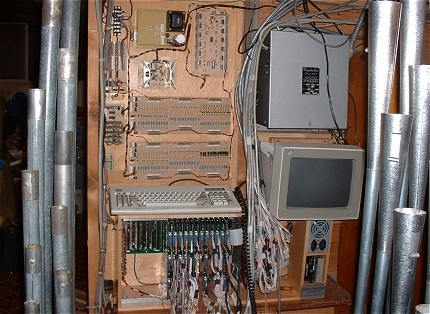
Tom Caulton electronic relay
Update from Ron, May 2013:
The first picture is a Morton open flute to replace the stopped flute. It gives the proper concert flute tone. The second is an oboe horn. It gives the tone color much like the sax. This is rich in the odd harmonics and is a good contrast to the harmonic tuba. The third is a picture of the console with the new tabs. You can see that 12 ranks is about the limit for a single rail console. The solo to great 16 fills in the tabs missing from the great for big registrations. The oboes were made by American Organ Co. which was bought out by Organ Supply Industries long ago. They are voiced and regulated on 7" wind for the house. I had to miter the bottom 8 pipes to make them fit in the chamber, but with 60 degree bends there is no change in tone. I now have microphones in the tone chute and feed the sound to an Alisis Digital reverb unit. This sound is added to the Direct sound. A small amount doesn't make it louder, but it reduces the dry studio sound and adds some "hall" effect.
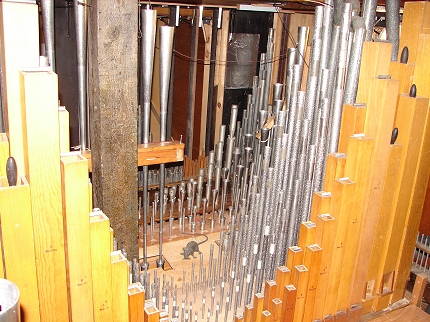
Morton Flute in foreground
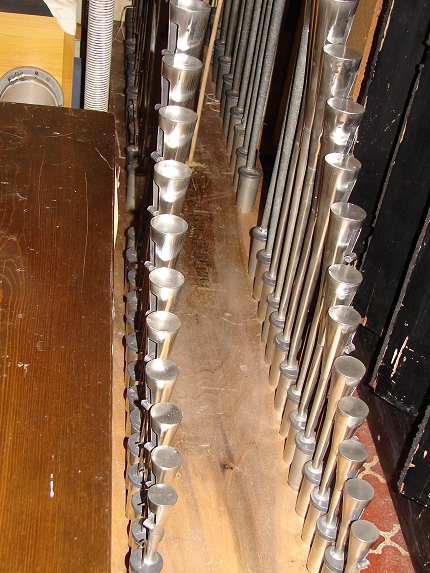
Oboe Horn

Rodgers console now outfitted for 12 ranks
About this site
© PSTOS, 1998-2013
